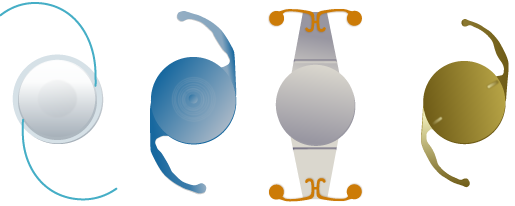A cataract is the clouding of the eye’s naturally clear lens. The lens is part of the eye that helps focus light on the retina. The retina is a light-sensitive layer of tissue lining the inner surface of the eye. The optics of the eye create an image of the visual world on the retina through the cornea and lens.
The clouding caused by a cataract reduces the sharpness of images reflected in the retina resulting in blurred vision. Most cataracts are related to aging, usually starting at age 40. Cataracts are so common that by age 80 more than half of all Americans either have a cataract or have already had cataract surgery.
While cataract surgery is one of the most common and successful surgeries performed today, there are some complications that can arise.
A cataract is caused by one of two changes in the lens: clumping of protein or discoloration. The lens is primarily composted of water and protein. In the case of a cataract the protein clumps up in areas clouding the lens and reducing the amount of light that reaches the retina. This can start with small clumps and increase in size to completely cover the lens requiring cataract surgery.
In the case of discoloration the lens slowing changes to a yellow and/or brownish color. Over time this brown tint to the lens becomes more prominent making it difficult to read and identify colors such as blues, purples, and blacks. Gradual discoloration of lenses does not affect the sharpness of the image. The natural wear and tear on eyes due to job requirements, lifestyle and environment are possible factors causing cataracts

Refractive cataract surgery means performing cataract surgery with emphasis on achieving the best possible vision without glasses as possible, just as we do with our LASIK patients.
To achieve this we begin with the doctor making the key measurements and using the best and latest technology to achieve this. Of course, we need excellence in performing thousands of cataract surgeries. We offer a multitude of intraocular lens options. For patients with astigmatism, Dr. Ehrlich performs limbal relaxing incisions or LRI’s, or uses a special astigmatic or TORIC implant, or both.
For patients wishing to have the most freedom from glasses, he offers the Crystalens HD and ReStor multifocal lenses. Dr. Ehrlich was selected to perform the FDA trial that led to the approval of the Crystalens, an honor given to 18 surgeons in the United States who were felt to have the skills and track record to turn out the excellent results that would and did lead to the approval of the lens.
A refractive lensectomy refers to performing refractive cataract surgery on a younger patient who does not yet have a clinically significant cataract but who desires the visual benefits from this technology. This includes patients who are too nearsighted or too farsighted to safely have LASIK, as well as patients who could have LASIK but desire both the far and reading vision available with a multifocal implant that is not available with LASIK. (The exception in LASIK is treating one eye for distance vision and one for reading, a process known as monovision.
An IOL stands for intraocular lens. It replaces your body’s own natural lens/cataract and there are now more options available to replace your body’s own lens including premium channel lens that consist of either the multifocal type or the accommodative type.

What is astigmatism?
Astigmatism is when the lens or cornea is not perfectly round. It causes a distortion to your vision. Astigmatism in the lens (or lenticular astigmatism), is automatically eliminated or reduced at the time of cataract surgery just by removing the lens. Corneal astigmatism remains after cataract surgery and if not surgically corrected, will require you to have to wear glasses for distance, intermediate and near after surgery. If the astigmatism is corrected with either a Toric lens or Refractive Limbal Relaxing Incisions, then you will be less dependent on wearing glasses all the time.
What is the difference between the toric lens and the incisions to correct astigmatism?
The Toric lens corrects astigmatism inside the eye whereas astigmatic incisions are on the surface of the eye rounding out the cornea. The Toric lens is more accurate and does not require any additional incisions other than the incision for the cataract surgery. Therefore the patient is usually more comfortable and notes that vision is more clear after the procedure. If you have a large amount of astigmatism, you may require a combination of a Toric lens with astigmatic incisions. For smaller amounts of astigmatism and with patients who heal at a normal rate, astigmatic incisions should work just fine.